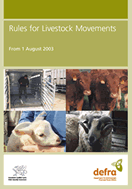 |
|||||||||
|
|||||||||||||||||||
|
|
Severe penalties face poor record keepers Inspecting 'the movement
book' is a core activity when Trading Standards carry out a routine
inspection on your farm, writes
Graham Winder, of Cumbria Trading Standards. We may also want
to see it if we are investigating apparent breaches of movement
legislation. Most of the time our inspections are to assess whether
you are complying with whatever the current rules are, and we will
offer
advice if you're not. Inspecting 'the movement
book' is a core activity when Trading Standards carry out a routine
inspection on your farm, writes
Graham Winder, of Cumbria Trading Standards. We may also want
to see it if we are investigating apparent breaches of movement
legislation. Most of the time our inspections are to assess whether
you are complying with whatever the current rules are, and we will
offer
advice if you're not.Maintaining up to date, accurate records of animal movements can serve a variety of purposes. For example, helping to control the spread of disease, and providing supporting evidence for subsidy claims. Most stock keepers will be familiar with making entries in the on-farm book, but increasingly producers use computer software which can allow a variety of records to be updated by entering information only once. This saves time, but also ensures consistency across all records, whether for your own management purposes, or to meet statutory requirements. Whether you use a movement book or herd register, or a computer, we have powers to inspect your records. If they are kept on computer the inspector can insist you provide him with a printed copy. Records must be produced to an inspector on demand, and you must allow him to make a copy. Failure to do so can lead to prosecution for obstruction, which although rare, does happen sometimes, and can carry a heavy penalty. The legal requirements for what information you record and when, vary according to what species of animals you keep. In all cases you must identify the animal, which premises it has moved between, and when. For cattle you must also record birth details, as well as notifying BCMS. For sheep, goats and pigs you also have to complete the movement declaration form AML1 or AML2, and if you are the recipient of one, forward it to us within three days. Records must be retained for ten years for cattle and six months for sheep, goats and pigs. Copies of AML1/2 forms must be retained for six months. The Animal By-Products Regulation which outlaws the on farm burial of livestock carcases also requires you to record where the carcase has been consigned to. Often the most convenient place to do this is in the movement record. As with obstruction, there are possible penalties for failing to comply with record keeping and movement notification requirements. In July this year a Cumbrian sheep farmer/dealer pleaded guilty and was fined £600 for failing to accurately record animal movements, as well as £100 for failing to produce a record to an inspector. He had also breached the standstill six times to which he also pleaded guilty, and was fined £1200. The maximum penalties are much more severe, each offence attracting a possible fine of up to £5000, up to six months imprisonment, or both. In addition to keeping movement records you must also maintain records of what veterinary medicines have been given to your stock, and if you mix feed on the farm, for example combining a straight feed with a mineral supplement, you must register with us and keep records. |
||||||||||||||||||

|
|
||||||||||||||||||
| home | agri-services | pedigree
pen | news | dairy | beef | machinery property | organisations | site map |
|||||||||||||||||||